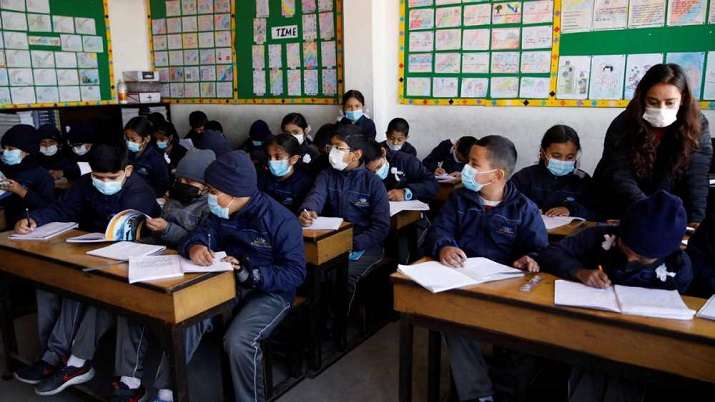It's been a long time coming, and now it's almost here.
Last August we reported that China's Commerce Ministry had released fresh details of a pilot program for the country's central bank digital currency (CBDC)
to be expanded to several metropolitan areas, including Guangdong-Hong
Kong-Macao Greater Bay Area, Beijing-Tianjin-Hebei region, and Yangtze
River Delta region. This was the inevitable culmination of a process
which started back in 2014 when as we reported at the time, "China Readies Digital Currency, IMF Says "Extremely Beneficial".
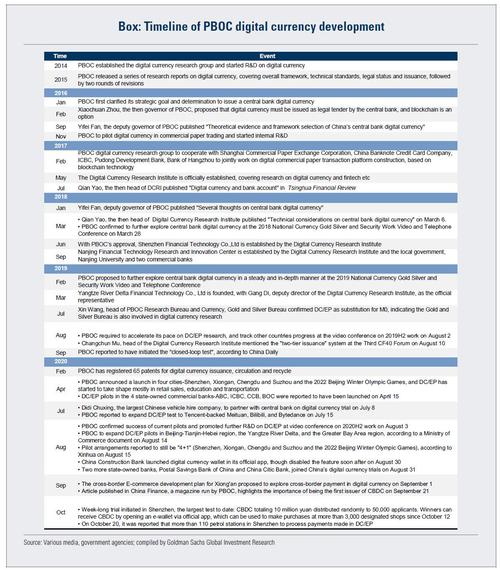
Fast forward a few months when China's preparations to rollout a digital yuan gathered pace, and we reported in October that China
was poised to give legal backing to the launch of its own sovereign
digital currency, "cementing its trailblazer status in virtual
currencies far ahead of other countries, after already recently
experimenting with large-scale trials of actual payments by consumers,
which was met with mixed results." Specifically, the South China Morning
Post reported that
"The People’s Bank of China published a draft law on Friday that would
give legal status to the Digital Currency Electronic Payment (DCEP)
system, and for the first time the digital yuan has been included and defined as part of the country’s sovereign fiat currency."
The
design framework for the digital yuan had been released one year ago on
the heels of Facebook's ambitious but disastrous Libra token rollout
after founding corporate partners split for lack of confidence in the
project and on fears US federal regulators would seek to block it just
as they did encrypted-messaging company Telegram's Gram cryptocurrency.
"The
draft law would also forbid any party from making or issuing
yuan-backed digital tokens to replace the renminbi in the market," the
SCMP said.
This in turn brought us to the so-called "Shenzhen case study" when in October of 2020, China became the first nation to hold a trial run of its digital currency, when the government in Shenzhen carried out a lottery to give away a total of 10 million yuan (about $1.5 million) worth of the digital currency (nearly 2 million people applied and 50,000 people actually "won").
The
winners were required to download a digital Renminbi app in order to
receive a "red packet" worth 200 digital yuan ($30), which they can then
spend at over 3,000 designated retailers in Shenzhen’s Luohu district,
according to China Daily. After that, they’ll be able to buy goods from
local pharmacies, supermarkets and even Walmart.
The idea was to
not only test the technology involved, but boost consumer spending in
the wake of the COVID-19 pandemic. In short, China is not only
subsidizing the centrally-planned economy by manipulating the
supply-side of the question- it now can prop up demand by handing out
digital currency to anyone (or everyone).
Of
course, unlike traditional central bank account-based currencies such
as reserves, or decentralized cryptocurrencies like bitcoin, China’s
digital currency would be controlled by the country’s central bank and will be instantly made available at a moment's notice to anyone who can receive it.
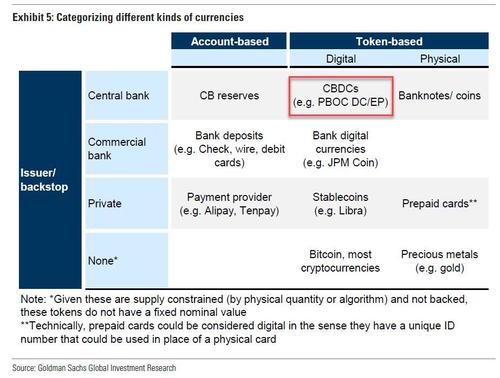
And
since "China's adoption of digital central bank tokens is expected to
be seamless as most of the nation's digital payments already pass
through companies like TenCent and AliPay and are already very popular
in the country", we concluded that "the successful Shenzhen test means that a broad rollout is just a matter of time."
Still,
one thing was missing: a stamp of approval by the gatekeeper of not
only the global payments system, but the protector of the dollar reserve
system, SWIFT. But as two months ago, China got that too: as we reported in February, "SWIFT, the global system for financial messaging and cross-border payments, has
set up a joint venture with the Chinese central bank’s digital currency
research institute and clearing centre, in a sign that China is
exploring global use of its planned digital yuan."
Actually,
not just "exploring" but thanks to year of testing and partial
rollouts, Beijing was about to become the first country in the world set
to launch the digital yuan, and with both the IMF's and SWIFT's blessing, we said that it was "just a matter of months if not weeks."
We were right, because just a few days ago, China's "cyber yuan" became official when the WSJ finally caught up, writing "China Creates Its Own Digital Currency, a First for Major Economy."
While
regular Zero Hedge readers are quite familiar with the details and
chronology of China's transition to a digital currency, which
incidentally is precisely the opposite of a cryptocurrency and has absolutely nothing to do with Bitcoin,
a fact which Peter Thiel may want to dwell on a little more next time
before making sweep and wrong statements about bitcoin, the WSJ focuses
more on the geopolitical reasons of China's currency evolution - as a
reminder, thousand years ago, when money meant coins, China invented
paper currency, and now the Chinese government is minting cash
digitally, in what the WSJ said is a "re-imagination of money that could
shake a pillar of American power" - and specifically how to approach a
decoupling from the global reserve currency, the US dollar so not only
can Beijing avoid the "nuclear option", a weaponized US dollar, but allow countries that the US seeks to punish like Iran, a viable alternative (remember, the enemies of China's enemies - and none is bigger than the US - is China's friend). Here is the WSJ:
The
U.S., as the issuer of dollars that the world’s more than 21,000 banks
need to do business, has long demanded insight into major cross-border
currency movements. This gives Washington the ability to freeze
individuals and institutions out of the global financial system by
barring banks from doing transactions with them, a practice criticized
as “dollar weaponization.”
...
The digital yuan
could give those the U.S. seeks to penalize a way to exchange money
without U.S. knowledge. Exchanges wouldn’t need to use SWIFT,
the messaging network that is used in money transfers between commercial
banks and that can be monitored by the U.S. government.
To
be sure, a credible alternative to the dollar, reduces the need to
hoard the currency for US trade partners which in turn would have
profound implications on global saving patterns, from there, global
capital flows. The consequences for the perpetual US current account
deficit would be unprecedented.
In addition to realigining the
global balance of monetary power virtually overnight, China's the
digital currency kills another bird with the same binary stone: it allows unprecedented surveillance and supervision over every single transaction.
[The
digital yuan is] also trackable, adding another tool to China’s heavy
state surveillance. The government deploys hundreds of millions of
facial-recognition cameras to monitor its population, sometimes using
them to levy fines for activities such as jaywalking. A digital currency would make it possible to both mete out and collect fines as soon as an infraction was detected.
A
burst of cash-accumulation in China last year indicates residents’
concern about the central bank’s eye on every transaction. Song Ke, a
finance professor at Renmin University in Beijing, told a recent
conference that China’s measure of yuan in circulation, or cash, popped
up 10% in 2020.
Then there are the myriad boosts to China's ironclad capital controls:
While
China hasn’t published final legislation for the program, the central
bank says it may initially impose limits on how much digital yuan
individuals can keep on their person, as a way to control how it
circulates and provide users a dose of security and privacy.
To be sure, none of this is actually new as we have discussed all these nuances of the digital yuan before. What is now, is this blurb in the WSJ article:
The
money itself is programmable. Beijing has tested expiration dates to
encourage users to spend it quickly, for times when the economy needs a
jump start.
And there you have it: the Keynesian wet dream to boost the velocity of mean finally comes true.
For the past decade we have joked that it is only a matter of time
before central banks slap on an expiration date on every monetary unit
in circulation...
... to offset the creeping petrification of the monetary system, where negative rates have sparked even more saving and not spending as central banks had intended...
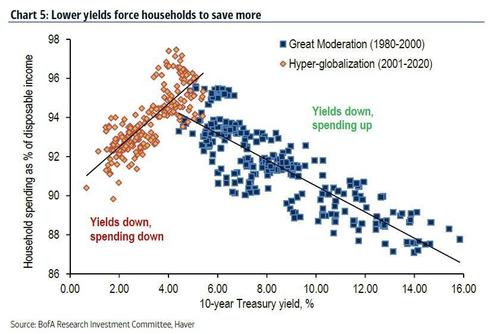
...
and where only the threat of money confiscation - which is what a
monetary expiration date actually does - can spark aggressive spending,
and eventually, runaway inflation.
Well, that's precisely what
China is now ready to do... and it's only a matter of time before other
central banks follow suit. As a reminder, according to tentative
estimates for the rollout of ISO 20022, which is the required universal
transaction standard which will make payment in digital currencies
possible, we are looking at a 2022 launch date, although China looks
ready to go live as soon as this year.
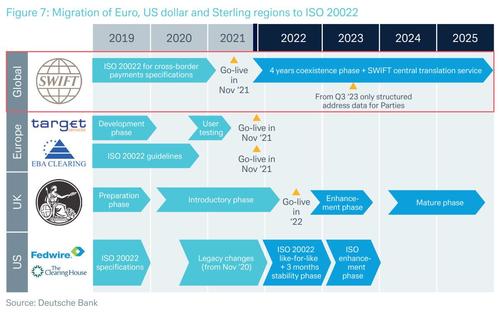
There is one final, geopolitical reason behind China's decision to give its digital currency an expiration date: as Byrne Hobart writes,
"programmable money, tied to real-world identities, and universally
tracked by a central bank, starts to look suspiciously like a substitute
for the consumer of last resort. Every year that China gets richer,
domestic consumption plays a bigger role (exports were 26% of China's
GDP in 2010, and 18% last year). If domestic consumption can be
tightly controlled, then it's a way to not just increase the volume of
consumption but to control the variance of demand for the goods China
produces. It's not yet enough to match the size and variability of global demand for China's exports, but every year it gets closer."
In
short, while the US and China are both talking seriously about
decoupling, the digital yuan - which is now a reality - indicates that China's
government is not only more effectively planning for it, but will be
the first to fully sever all ties with the US... when the moment comes.
Finally,
for those who have missed our reporting on this fascinating issue, here
again is Rabobank's Wim Boonstra explaining not only why China will be
the first country to launch a digital currency but also looking at what
happens next:
China Will Be The First Country To Launch A Digital Currency: What Happens Then
- China may be the first major country to launch a central bank digital currency or CBDC
- The Chinese CBDC, named DCEP, will strengthen the position of the central bank and help to further modernize the Chinese economy
- The DCEP will probably also be available for China’s trade partners, to begin with Africa
- The DCEP may strengthen the international position of the renminbi to the detriment of the euro
- The arrival of the DCEP should be a strong wake-up call for Western, especially European, policymakers
Introduction
Most
central banks are busy preparing for the potential introduction of
central bank digital currency (CBDC). CBDC is a digital currency issued
by the central bank. It is sometimes referred to as a digital version of
a bank note, but in many cases this is not correct. There are indeed
many different potential variants.
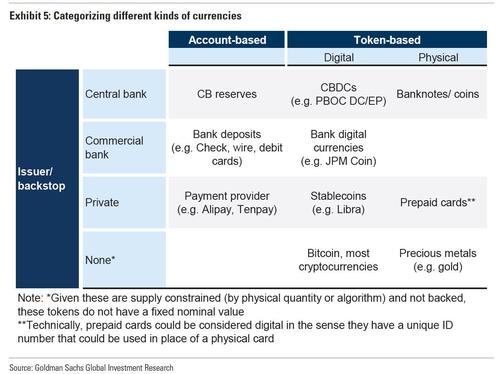
So far, virtually all the central banks are keeping their options open as to whether a CBDC will ultimately appear.
China, where a far-reaching trial is under way, is the major exception. If
this trial is successful, one can expect the Chinese CBDC to be
introduced widely in the near future. China is therefore comfortably
leading the way because the country has big ambitions for its digital
currency. First, it should provide a sizable boost to the Chinese
economy; second, it will concurrently further increase the Chinese
government’s control of Chinese society; finally, the new currency is
part of an ambitious plan to strengthen the international position of
the renminbi, the Chinese currency, and potentially at the expense of
the euro in particular. This Chinese decisiveness should spur European
policymakers into action by further strengthening the euro.
China: from cash-based to almost completely cashless money in 10 years’ time
Not
so long ago, retail payments in China were still almost entirely made
in cash. There has been a revolution in payments traffic since that
time, and China is now one of the leading countries in cashless
payments. Unlike in other countries, such as the Netherlands and Sweden,
in China this development did not originate from the banking system,
but it was induced by a few key apps from relatively young Fintech
companies such as WeChat (Tencent) and Alipay (Ant Financial). These
parties, that form a kind of extra layer between the banks and their
customers, now have a collective market share of more than 90% in
Chinese payments cashless retail payments. The Chinese cashless payments
system is already able to settle approximately 100,000 transactions per
second.
The Chinese CBDC: DCEP
Against
this background, the People’s Bank of China (PBoC), the Chinese central
bank, has taken the initiative of developing its own digital currency
known as the Digital Currency Electronic Payment (DCEP). Above
all, the DCEP is a digital alternative to bank notes, although it has
features that differ from cash in certain respects (see below). The DCEP
does however have the same value as a renminbi.
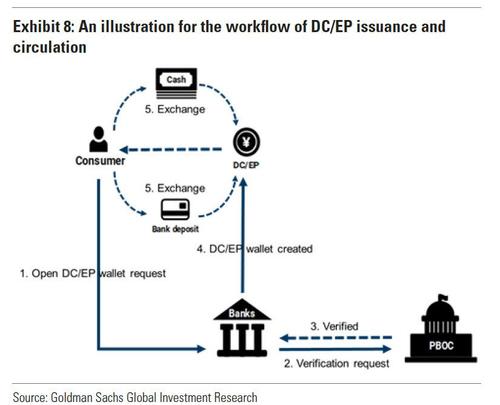
The
technology that can be used by the public for payments is based on
traditional payment technology and not on blockchain technology. This is
the only way to achieve the necessary scale. The aim is to reach a capacity of 300,000 transactions per second.
The central bank might itself use blockchain, for example for wholesale
transactions or settlements in DCEP between private banks. Although the
DCEP is a cashless currency that will be held in an account with a
private entity, there is also the possibility of using a token-based
functionality on for example a chip to effect peer-to-peer payments,
even where there is no Internet. This is especially needed for
successful adoption in the rural areas of China. This token-based
functionality will be widely used, as a result of which the DCEP will
compete with cash. A sizable trial has been running for several months in which tens of thousands of people have been participating.
What does the PBoC want to achieve with the DCEP?
The PBoC has several objectives with the introduction of the DCEP.
Prevention of a monopoly in the payment system
The PBoC wants to prevent a situation in which WeChat and AliPay take over the Chinese payment system.
It is concerned that the entire payment system will soon fall into the
hands of these private parties. The DCEP therefore has to restrict the
involvement of these parties and increase the role of the central bank
in the payment system. It is even more likely that any key
private firm will be prevented to become a dominant player, as
ultimately China is not a ‘normal’ market economy (which explains
Beijing's current crackdown on Ant Financial far better than just a feud between Xi Jinping and Jack Ma).
Promotion of financial inclusion and further reduction of the role played by cash
Highly
efficient cashless payments dominate in large parts of China. But in
the poorer regions, especially the rural areas, people have less access
to banking services such as regular credit. In these areas, cash still
plays an important role. Payments in the criminal underworld, including
the illegal gambling industry, are also still largely made in cash. The
DCEP will offer people in these regions full access to financial
services, but it can also reduce the importance of cash payments. The main aim of the DCEP is therefore to replace cash. In terms of features, it will also closely resemble cash.
Better information on payment flows and prevention of illegal transactions
Unlike
payment transactions using a bank account, which by definition leave
traces in a bank’s records, cash payments are highly anonymous. As we
have said, the DCEP will closely resemble cash, with the possibility of
making payments directly from one person to another. Some degree of
anonymity would thus appear to be safeguarded. But on further consideration, it becomes clear that the PBoC, and therefore the Chinese government, will have full insight.
To
be precise, in a transaction between two people effected with DCEP,
anonymity between these two people will be assured, as is the case with a
cash payment. But the PBoC can always establish at a later date who
were involved in the transaction. This will enable more effective tracing of illegal transactions than if these were effected in cash. But there will also be detailed insight into the payment behavior of individuals.
Restricting capital flight
Although
China does not have free cross-border capital movements, capital flight
is a common and substantial phenomenon. Capital flight can occur in
various ways, and is often difficult to trace. For example,
internationally trading Chinese companies can for instance manipulate
invoices, as a result of which money can be transferred abroad. People
can also use the Bitcoin system to hide money from the authorities
and/or transfer it abroad.
The Chinese government, like its counterparts in Europe and the US, is concerned that stablecoins could assume an important role as an alternative to the regular money in circulation, but also may develop into a vehicle for capital flight (read "How The Chinese Use Illegal Online Gambling And Tether To Launder Over $1 Trillion Yuan").
Stablecoins are cryptos like Bitcoin, but unlike Bitcoin they are, at
least in theory, secured by financial assets. When Facebook announced in
April 2020 that it intends to add national stablecoins to its Libra, a
digital currency basket that it announced in 2019, central banks reacted
immediately by devoting more urgent attention to CBDC.23 Such
stablecoins could for example create the possibility that people could
use a Libra-stablecoin to transfer money abroad. With the DCEP, the PBoC intends to slow the momentum of private stablecoins. This is also an important consideration for the Western central banks.
Retention of monetary sovereignty
This
is connected with the previous point. If people have easy access to a
private stablecoin, it could actually in a sense reduce the role of the
national currency. Something similar actually happened in Zimbabwe,
where confidence in the national currency completely vanished as a
result of hyperinflation and people turned en masse to foreign
currencies such as US dollars and South African rand. In such a
situation, the national central bank loses control of monetary
conditions in its own country. Importantly, however, the DCEP could also be used by China to interfere with monetary sovereignty in other countries.
What about privacy?
The
PBoC says it will respect the privacy of people and therefore the
anonymity of the transactions but at the same time it says that DCEP
will help it to detect illegal transactions. What this probably comes
down to in practice is that people will be able to effect payments and
retain anonymity between each other, but that the central bank will on
the other hand be able to view the transactions. Anonymity will
therefore not be guaranteed and the central bank will have much greater
insight into people’s payment behaviour than it has at the moment. The
DCEP will also have the status of legal tender. This means that Chinese
residents will be obliged to accept the DCEP, as confirmed by various
statements from the central bank on the issue (South China Morning Post,
10 November 2020). The DCEP is thus not really coming into being as a
result of strong demand from the Chinese public, but it is being imposed
on the population by the government. Moreover, the way the DCEP
is designed, it may develop into a perfect vehicle for a quasi-command
economy: it allows all transactions to be monitored, and opens the door
for a retreat to a more Soviet model of banking, viz. banking under full
state control.
Internationalization of the renminbi
The
use of the renminbi in international transactions is still relatively
limited, certainly in comparison with the dollar and the euro. But
China is working steadily on increasing its usage, and even hopes that
one day the renminbi can succeed the dollar as the global reserve
currency. China sees the DCEP as an important vehicle for
strengthening the renminbi’s international position, as foreigners will
also be able to use the DCEP in transactions with China.
The
benefit of this for China is that it can settle more of its
international trade in (digital) renminbi. China has initially targeted
Africa in this respect. Many African countries do not have fully
convertible currencies and mutual trade is frequently settled in US
dollars, which is expensive. China is aiming to achieve a
situation in which African countries can use the DCEP not only in their
trade with China, but will also use it for their domestic transactions.
This is a good example of how China is aiming to position itself
internationally and how various projects and institutions will cooperate
under the direction of the government. The newest model of the Huawei
smartphone indeed includes an app enabling payment in DCEP without the
need for Internet (Eurasia). Huawei is currently already a leading
telecoms provider in Africa, which gives China a head start. In other
parts of the world, where Huawei is less dominant or even banned, it
will off course be less simple for China to push the DCEP ahead.
Note
that while China intends to strengthen its own monetary sovereignty
with the DCEP, it clearly has no qualms regarding its use to undermine
the monetary sovereignty of other countries. If not only a larger
proportion of the trade between China and African countries but also
part of intra-African trade could soon be settled in DCEP, therefore
renminbi, international use of the Chinese currency will significantly
increase. Note, that if a larger share of China’s international trade
will be conducted in DCEP, it will also become more difficult for
Chinese im- and exporters to use trade as a way to channel funds abroad.
So it will held the Chinese government to reduce capital flight,
although complete elimination of this phenomenon will not be possible.
Decision time: is the DCEP a wake-up call?
China
is leading internationally with the introduction of CBDC, and is
clearly moving in a different direction than many other countries
considering a similar move. The debate in Europe is still mainly about
the form the digital euro, its CBDC, should take, the question of
whether there is consumer demand for it, and who should pay for it. The
Chinese authorities are taking a more strategic approach, and most of
all from the perspective of whether a digital currency can contribute to
strengthening/entrenching China’s international position.
Assuming that the current Chinese trials are successful, we could very well see the DCEP appear as early as next year. This
could be a significant step in the further movement of the Chinese
economy towards cashless money. The payments system would be further
strengthened by the DCEP, as this will prevent large private parties
gaining a duopoly with the market power that this would entail.
Financial inclusion would be improved in the underdeveloped areas, and
everyone would have access to cashless money and the associated
financial services that this would make possible. The black economy
would be further reduced, and the Chinese government will have better
insight (and control) of the payment behaviour of its citizens to an
extent that we in the West would probably see as unacceptable. Lastly,
the introduction of the DCEP can discourage capital flight and probably
strengthen the renminbi’s international position.
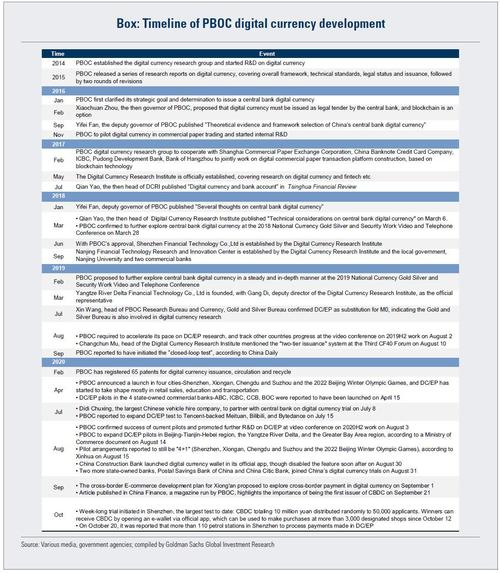
All
in all, the DCEP will certainly make a positive contribution to the
further development of the Chinese economy. Although the DCEP looks to
be less innovative than the CBDCs under consideration by the Western
central banks in certain respects, the determination shown by China is
undoubtedly impressive.
This Chinese resoluteness also shows that
China is working very actively on strengthening the renminbi’s
international position, with the central bank and companies such as
Huawei working closely together to achieve this. While still a long way
off, a scenario in which first parts of the African, but later maybe
Asian, Latin American of even some European economies will use the
renminbi for cross-border and in due course also domestic transactions
is gradually becoming more plausible.
One may also expect China to
try to get all countries involved in its Belt and Road Initiative to
use the DCEP and therefore the renminbi. Today, the renminbi is still a
small currency in comparison to the euro and most of all the dollar. But
this situation could change if the DCEP becomes widely accepted. In the
context of a situation in which the euro’s international position has
more or less stagnated over the last decades, this is at the very least
somewhat disconcerting.
Of course we may expect that, once the
digital renminbi takes off and gains traction, other central banks will
react strongly. Especially the US will be determined to hold on to the
dollar’s international dominance. The US authorities will soon
understand that a successful digital renminbi may in the long run turn
out to be a larger threat to the position of the dollar than the euro
ever was. The most important difference is that the euro is
institutionally weak and European politicians have so far failed to use
their currency as a geopolitical instrument. The Chinese
government, in contrast, understand very well the power of money as a
‘peaceful’ instrument to increase international political clout.
But
after all the good news may be, that the DCEP also turns out to be the
important wake-up call that prompts European policymakers to finally
devote serious attention to strengthening the international role of the
euro. Having the second currency after the US dollar is maybe not
optimal, but is not disastrous. Being third after the Chinese renminbi
is a different story. In the end, money talks.
* * *
Appendix: what will the DCEP look like?
The
exact design of the DCEP is still not clear. According to the BIS, the
DCEP will be what is known as a hybrid CBDC. People will hold balances
in their names at the central bank, but transactions will be approved
using an intermediate layer of private parties (possibly including
commercial banks). There will then be no direct interaction between the
central bank and the account holders, but people will have an account in
their names at the central bank. This would be similar to the ideas
being mooted at other central banks such as the ECB and the Bank of
England. Bloomberg, Blockchain News and the China Daily on
the other hand describe the DCEP as a two-tier system, in which people
will not directly hold accounts with the PBoC. According to these
reports, in the Chinese system people will hold only a DCEP account with
a bank or, more likely, with a payment service provider. These parties
will in turn hold a balance with the PBoC as a liquidity reserve that
exactly covers the amount of DCEP. They will also settle interbank
payments in DCEP. This kind of system is also known as a synthetic CBDC
(sCBDC), as people will not have their own CBDC accounts with the
central bank. The PBoC will however receive regular statements of
effected transactions.
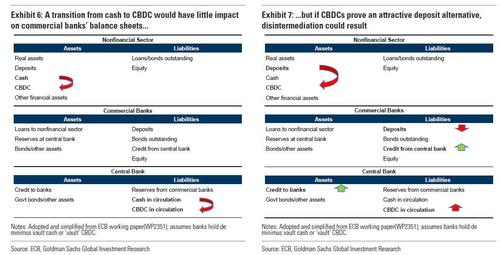
If
this last model is adopted, the Chinese CBDC model would be more like a
full (liquidity) reserve bank than a real CBDC. A full liquidity
reserve bank is a bank that would hold a 100% cash reserve with the
central bank against the CBDC payment accounts held with it. But in the
Chinese model, there would be no additional institution created, the
existing financial institutions would offer additional accounts that
would then be 100% backed by central bank reserves. Statements from the
PBoC also suggest the direction is more towards a synthetic model.
Technically speaking, this would represent a less innovative move than a
true CBDC.
source: Zerohedge
